Ni-MoO2 Composite Coatings Electrodeposited at Porous Ni Substrate as Efficient Alkaline Water Splitting Cathodes
Abstract
:1. Introduction
- the metallic type of conductivity that MoO2 exhibits (10−2 S cm−1 at room temperature according to literature data [37]); therefore, it cannot be considered a non-metallic particle;
- in our previous investigations, MoO2 powders were obtained by the rheological process [8], most probably containing not only MoO2 particles but also an unknown amount of other non-stoichiometric Mo oxides, while in this case pure MoO2 powder (commercially available) was used.
2. Materials and Methods
2.1. Electrodeposition of Ni-MoO2 Composite Coatings on Ni Foam
2.2. Physico-Chemical Characterization
2.3. HER Investigation
2.4. Zero-Gap Single Cell Measurements
3. Results and Discussion
3.1. Physico-Chemical Characterization
Cross-Section Light Microscopy (LM)
3.2. HER Polarization Curves in 1.0 M KOH at 25 °C
3.3. HER Investigation in 30% KOH at 70 °C
3.4. Investigations in a Single, Zero-Gap Membrane Cell
4. Conclusions
Author Contributions
Funding
Institutional Review Board Statement
Informed Consent Statement
Data Availability Statement
Acknowledgments
Conflicts of Interest
References
- Li, Q.; Hou, Y.; Yin, J.; Xi, P. The Evolution of Hexagonal Cobalt Nanosheets for CO2 Electrochemical Reduction Reaction. Catalysts 2023, 13, 1384. [Google Scholar] [CrossRef]
- Koolen, C.D.; Oveisi, E.; Zhang, J.; Li, M.; Safonova, O.V.; Pedersen, J.K.; Rossmeisl, J.; Luo, W.; Züttel, A. Low-temperature non-equilibrium synthesis of anisotropic multimetallic nanosurface alloys for electrochemical CO2 reduction. Nat. Synth 2024, 3, 47–57. [Google Scholar] [CrossRef]
- Kuznetsova, I.; Lebedeva, O.; Kultin, D.; Mashkin, M.; Kalmykov, K.; Kustov, L. Enhancing Efficiency of Nitrate Reduction to Ammonia by Fe and Co Nanoparticle-Based Bimetallic Electrocatalyst. Int. J. Mol. Sci. 2024, 25, 7089. [Google Scholar] [CrossRef]
- Xiang, D.; Bao, J.; Zhang, L.; Xin, P.; Yue, C.; Naseri, A.; Wang, H.; Huang, S.; Uvdal, K.; Hu, Z. Interfacial electronic structure modulations of Au@CuS with defective Ni-doped CoS2 facilitates the electroreduction of N2 into NH3. Chem. Eng. J. 2024, 493, 152456. [Google Scholar] [CrossRef]
- Rocha, F.; Delmelle, R.; Georgiadis, C.; Proost, J. Effect of pore size and electrolyte flow rate on the bubble- removal efficiency of 3D pure Ni foam electrodes during alkaline water electrolysis. J. Environ. Chem. Eng. 2022, 10, 107648. [Google Scholar] [CrossRef]
- Wang, N.; Song, S.; Wu, W.; Deng, Z.; Tang, C. Bridging Laboratory Electrocatalysts with Industrially Relevant Alkaline Water Electrolyzers. Adv. Energy Mater. 2024, 14, 2303451. [Google Scholar] [CrossRef]
- Technical Targets for Liquid Alkaline Electrolysis. Available online: https://www.energy.gov/eere/fuelcells/technical-targets-liquid-alkaline-electrolysis (accessed on 20 June 2024).
- Clean Hydrogen JU-SRIA Key Performance Indicators (KPIs). Available online: https://www.clean-hydrogen.europa.eu/knowledge-management/strategy-map-and-key-performance-indicators/clean-hydrogen-ju-sria-key-performance-indicators-kpis_en (accessed on 18 June 2024).
- Buch, C.G.; Cardona, I.H.; Ortega, E.; Anton, J.G.; Herrenz, V.P. Study of the catalytic activity of 3D macroporous Ni and NiMo cathodes for hydrogen production by alkaline water electrolysis. J. Appl. Electrochem. 2016, 46, 791–803. [Google Scholar] [CrossRef]
- Shetty, S.; Hegde, A.C. Magnetically Induced Electrodeposition of Ni-Mo Alloy for Hydrogen Evolution Reaction. Electrocatalysis 2017, 8, 179–188. [Google Scholar] [CrossRef]
- Rao, D.; Wang, L.; Zhu, Y.; Guo, R.; Li, Z. Electrochemical Preparation of Ni-Mo Coated Coral-Like Cu Micro-Arrays for Electrocatalytic Hydrogen Evolution Reaction in Acidic Solution. J. Electrochem. Soc. 2016, 163, H1026–H1032. [Google Scholar] [CrossRef]
- Wang, X.; Su, R.; Aslan, H.; Kibsgaard, J.; Wendt, S.; Meng, L.; Dong, M.; Huang, Y.; Besenbacher, F. Tweaking the composition of NiMoZn alloy electrocatalyst for enhanced hydrogen evolution reaction performance. Nano Energy 2015, 12, 9–18. [Google Scholar] [CrossRef]
- Ren, B.; Li, D.; Jin, Q.; Cui, H.; Wang, C. Integrated 3D self-supported Ni decorated MoO2 nanowires as highly efficient electrocatalysts for ultra-highly stable and large-current-density hydrogen evolution. J. Mater. Chem. A 2017, 5, 24453–24461. [Google Scholar] [CrossRef]
- Krstajić, N.V.; Lačnjevac, U.; Jović, B.M.; Mora, S.; Jović, V.D. Non-noble metal composite cathodes for hydrogen evolution. Part II–The Ni-MoO2 coatings electrodeposited from nickel chloride-ammonium chloride bath containing MoO2 powder particles. Int. J. Hydrog. Energy 2011, 36, 6450–6461. [Google Scholar] [CrossRef]
- Lopez, D.E.; Niu, Y.; Yin, J.; Cooke, K.; Rees, N.V.; Palmer, R.E. Enhancement of the Hydrogen Evolution Reaction from Ni-MoS2 Hybrid Nanoclusters. ACS Catal. 2016, 6, 6008–6017. [Google Scholar] [CrossRef]
- Xing, Z.; Yang, X.; Asiri, A.M.; Sun, X. Three-Dimensional Structures of MoS2@Ni Core/Shell Nanosheets Array toward Synergetic Electrocatalytic Water Splitting. ACS Appl. Mater. Interfaces 2016, 8, 14521–14526. [Google Scholar] [CrossRef] [PubMed]
- Jiang, J.; Gao, M.; Sheng, W.; Yan, Y. Hollow Chevrel-Phase NiMo3S4 for Hydrogen Evolution in Alkaline Electrolytes. Angew. Chem. Int. Ed. 2016, 55, 15240–15245. [Google Scholar] [CrossRef]
- Guo, J.; Zhang, X.; Sun, Y.; Tang, L.; Zhang, X. NiMoS3 Nanorods as pH-Tolerant Electrocatalyst for Efficient Hydrogen Evolution. ACS Sustain. Chem. Eng. 2017, 5, 9006–9013. [Google Scholar] [CrossRef]
- Xu, W.; Fan, G.; Zhu, S.; Liang, Y.; Cui, Z.; Li, Z.; Jiang, H.; Wu, S.; Cheng, F. Electronic structure modulation of nanoporous cobalt phosphide by carbon doping for alkaline hydrogen evolution reaction. Adv. Funct. Mater. 2021, 31, 2107333. [Google Scholar] [CrossRef]
- Huang, Y.; Hu, L.; Liu, R.; Hu, Y.; Xiong, T.; Qiu, W.; Balogun, M.S.; Pan, A.; Tong, Y. Nitrogen treatment generates tunable nanohybridization of Ni5P4 nanosheets with nickel hydr(oxy)oxides for efficient hydrogen production in alkaline, seawater and acidic media. Appl. Catal. B 2019, 251, 181–194. [Google Scholar] [CrossRef]
- Zhuang, L.; Li, S.; Li, J.; Wang, K.; Guan, Z.; Liang, C.; Xu, Z. Recent Advances on Hydrogen Evolution and Oxygen Evolution Catalysts for Direct Seawater Splitting. Coatings 2022, 12, 659. [Google Scholar] [CrossRef]
- Ashby, M.F.; Evans, A.G.; Fleck, N.A.; Gibson, L.J.; Hutchinson, J.W.; Wadley, H.N.G. Metal Foams: A Design Guide; Butterworth-Heinemann: Woburn, MA, USA, 2000; pp. 6–20. [Google Scholar]
- Gojgić, J.D.; Petričević, A.M.; Rauscher, T.; Bernäcker, C.I.; Weißgärber, T.; Pavko, L.; Vasilić, R.; Krstajić Pajić, M.N.; Jović, V.D. Hydrogen evolution at Ni foam electrodes and Ni-Sn coated Ni foam electrodes. Appl. Catal. A Gen. 2023, 663, 119312. [Google Scholar] [CrossRef]
- Jakšic, M.M. Electrocatalysis of hydrogen evolution in the light of the brewer-engel theory for bonding in metals and intermetallic phases. Electrochim. Acta 1984, 29, 1539–1550. [Google Scholar] [CrossRef]
- Hashimoto, K.; Sasaki, T.; Meguro, S.; Asami, K. Nanocrystalline electrodeposited Ni-Mo-C cathodes for hydrogen production. Mater. Sci. Eng. A 2004, 375–377, 942–945. [Google Scholar] [CrossRef]
- Niedbała, J.; Budniok, A.; Łagiewka, E. Hydrogen evolution on the polyethylene-modified Ni-Mo composite layers. Thin Solid Film. 2008, 516, 6191–6196. [Google Scholar] [CrossRef]
- Aaboubi, O. Hydrogen evolution activity of Ni-Mo coating electrodeposited under magnetic field control. Int. J. Hydrog. Energy 2011, 36, 4702–4709. [Google Scholar] [CrossRef]
- Jović, V.D.; Lačnjevac, U.; Jović, B.M.; Krstajić, N.V. Service life test of non-noble metal composite cathodes for hydrogen evolution in sodium hydroxide solution. Electrochim. Acta 2012, 63, 124–130. [Google Scholar] [CrossRef]
- Jović, V.D.; Krstajić, N.V.; Rauscher, T. Electrodeposited Ni-based, non-noble metal cathodes for hydrogen evolution reaction in alkaline solutions. In Advances in Energy Research; Acosta, M.J., Ed.; Nova Science Publishers, Inc.: Hauppauge, NY, USA, 2024; Volume 39, pp. 97–184. [Google Scholar]
- Zheng, H.Y.; An, M.Z. Electrodeposition of Zn-Ni-Al2O3 nanocomposite coatings under ultrasound conditions. J. Alloys Compd. 2008, 459, 548–552. [Google Scholar] [CrossRef]
- Katamipour, A.; Farzam, M.; Danaee, I. Effects of sonication on anticorrosive and mechanical properties of electrodeposited Ni-Zn-TiO2 nanocomposite coatings. Surf. Coat. Technol. 2014, 254, 358–363. [Google Scholar] [CrossRef]
- Lecina, G.E.; Urrutia, G.I.; Diez, J.A.; Fornell, J.; Pellicer, E.; Sort, J. Codeposition of inorganic fullerene-like WS2 nanoparticles in an electrodeposited nickel matrix under the influence of ultrasonic agitation. Electrochim. Acta. 2013, 114, 859–867. [Google Scholar] [CrossRef]
- Lecina, G.E.; Urrutia, G.I.; Diez, J.A.; Morgiel, J.; Indyka, P. A comparative study of the effect of mechanical and ultrasound agitation on the properties of electrodeposited Ni/Al2O3 nanocomposite coatings. Surf. Coat. Technol. 2012, 206, 2998–3005. [Google Scholar] [CrossRef]
- Shourgeshty, M.; Aliofkhazraei, M.; Karimzadeh, A. Study on functionally graded Zn-Ni-Al2O3 coatings fabricated by pulse-electrodeposition. Surf. Eng. 2018, 35, 167–176. [Google Scholar] [CrossRef]
- Exbrayat, L.; Rebere, C.; Eyame, R.N.; Steyer, P.; Creus, J. Corrosion behaviour in saline solution of pulsed-electrodeposited zinc-nickel-ceria nanocomposite coatings. Mater. Corros. 2017, 68, 1129–1142. [Google Scholar] [CrossRef]
- Zanella, C.; Lekka, M.; Rossi, S.; Deflorian, F. Study of the influence of sonication during the electrodeposition of nickel matrix nanocomposite coatings on the protective properties. Corros. Rev. 2011, 29, 253–260. [Google Scholar] [CrossRef]
- Chase, L.L. Optical properties of CrO2 and MoO2 from 0.1 to 6 eV. Phys. Rev. B 1974, 10, 2226–2231. [Google Scholar] [CrossRef]
- Malkow, T.; Pilenga, A.; Tsotridis, G.; De Marco, G. EU Harmonised Polarisation Curve Test Method for Low-Temperature Water Electrolysis; Publications Office of the European Union: Luxembourg, 2018. [Google Scholar]
- Gojgić, J.D.; Petričević, A.M.; Krstajić Pajić, M.N.; Jović, V.D. Correct determination of the hydrogen evolution reaction pa-rameters at Ni foam electrode modified by electrodeposited Ni-Sn alloy layer. Zaštita Mater. 2024, 65, 3–10. [Google Scholar]
- Jović, V.D. Calculation of a pure double layer capacitance from a constant phase element in the impedance measurements. Zaštita Mater. 2022, 63, 50–57. [Google Scholar] [CrossRef]
- Obradović, M.D.; Gojković, S.L.J. Challenges in determining the electrochemically active surface area of Ni-oxides in the oxygen evolution reaction. J. Electroanal. Chem. 2022, 918, 116479. [Google Scholar] [CrossRef]
- Cossar, E.; Houache, M.S.E.; Zhang, Z.; Baranova, E.A. Comparison of electrochemical active surface area methods for various nickel nanostructures. J. Electroanal. Chem. 2020, 870, 114246. [Google Scholar] [CrossRef]
- McCrory, C.C.L.; Jung, S.; Peters, J.C.; Jaramillo, T.F. Benchmarking heterogeneous electrocatalysts for the oxygen evolution reaction. J. Am. Chem. Soc. 2013, 135, 16977–16987. [Google Scholar] [CrossRef]
- McCrory, C.C.L.; Jung, S.; Ferrer, I.M.; Chatman, S.M.; Peters, J.C.; Jaramillo, T.F. Benchmarking Hydrogen Evolving Reaction and Oxygen Evolving Reaction Electrocatalysts for Solar Water Splitting Devices. J. Am. Chem. Soc. 2015, 137, 4347–4357. [Google Scholar] [CrossRef]
- Babic, U.; Suermann, M.; Buchi, F.N.; Gubler, L.; Schmidta, T.J. Review: Identifying Critical Gaps for Polymer Electrolyte WaterElectrolysis Development. J. Electrochem. Soc. 2017, 164, F387–F399. [Google Scholar] [CrossRef]
- De Groot, M.T.; Vremana, A.W. Ohmic resistance in zero gap alkaline electrolysis with a Zirfon diaphragm. Electrochim. Acta 2021, 369, 137684. [Google Scholar] [CrossRef]
- Tian, X.; Zhao, P.; Sheng, W. Hydrogen Evolution and Oxidation: Mechanistic Studies and Material Advances. Adv. Mater. 2019, 31, 1808066. [Google Scholar] [CrossRef] [PubMed]
- Zhang, E.; Song, W. Review—Self-Supporting Electrocatalysts for HER in Alkaline Water Electrolysis. J. Electrochem. Soc. 2024, 171, 052503. [Google Scholar] [CrossRef]
- Ďurovič, M.; Hnát, J.; Bouzek, K. Electrocatalysts for the hydrogen evolution reaction in alkaline and neutral media. A comparative review. J. Power Sources 2021, 493, 229708. [Google Scholar] [CrossRef]
- Zhang, J.; Wang, T.; Liu, P.; Liao, Z.; Liu, S.; Zhuang, X.; Chen, M.; Zschech, E.; Feng, X. Efficient hydrogen production on MoNi4 electrocatalysts with fast water dissociation kinetics. Nat. Commun. 2017, 8, 15437. [Google Scholar] [CrossRef]
- Jin, L.; Xu, H.; Wang, C.; Wang, Y.; Shang, H.; Du, Y. Multi-dimensional collaboration promotes the catalytic performance of 1D MoO3 nanorods decorated with 2D NiS nanosheets for efficient water splitting. Nanoscale 2020, 12, 21850. [Google Scholar] [CrossRef] [PubMed]
- Bao, F.; Kemppainen, E.; Dorbandt, I.; Bors, R.; Xi, F.; Schlatmann, R.; van de Krol, R.; Calnan, S. Understanding the Hydrogen Evolution Reaction Kinetics of Electrodeposited Nickel-Molybdenum in Acidic, Near-Neutral, and Alkaline Conditions. ChemElectroChem 2021, 8, 195. [Google Scholar] [CrossRef]
- Tang, Z.; Fu, Y.; Zhao, K.; Zhu, J.; Liang, H.; Lin, S.; Song, H.; Wu, W.; Zhang, X.; Zheng, C.; et al. Electrodeposited large-area nickel-alloy electrocatalysts for alkaline hydrogen evolution under industrially relevant conditions. J. Alloys Compd. 2024, 975, 172978. [Google Scholar] [CrossRef]
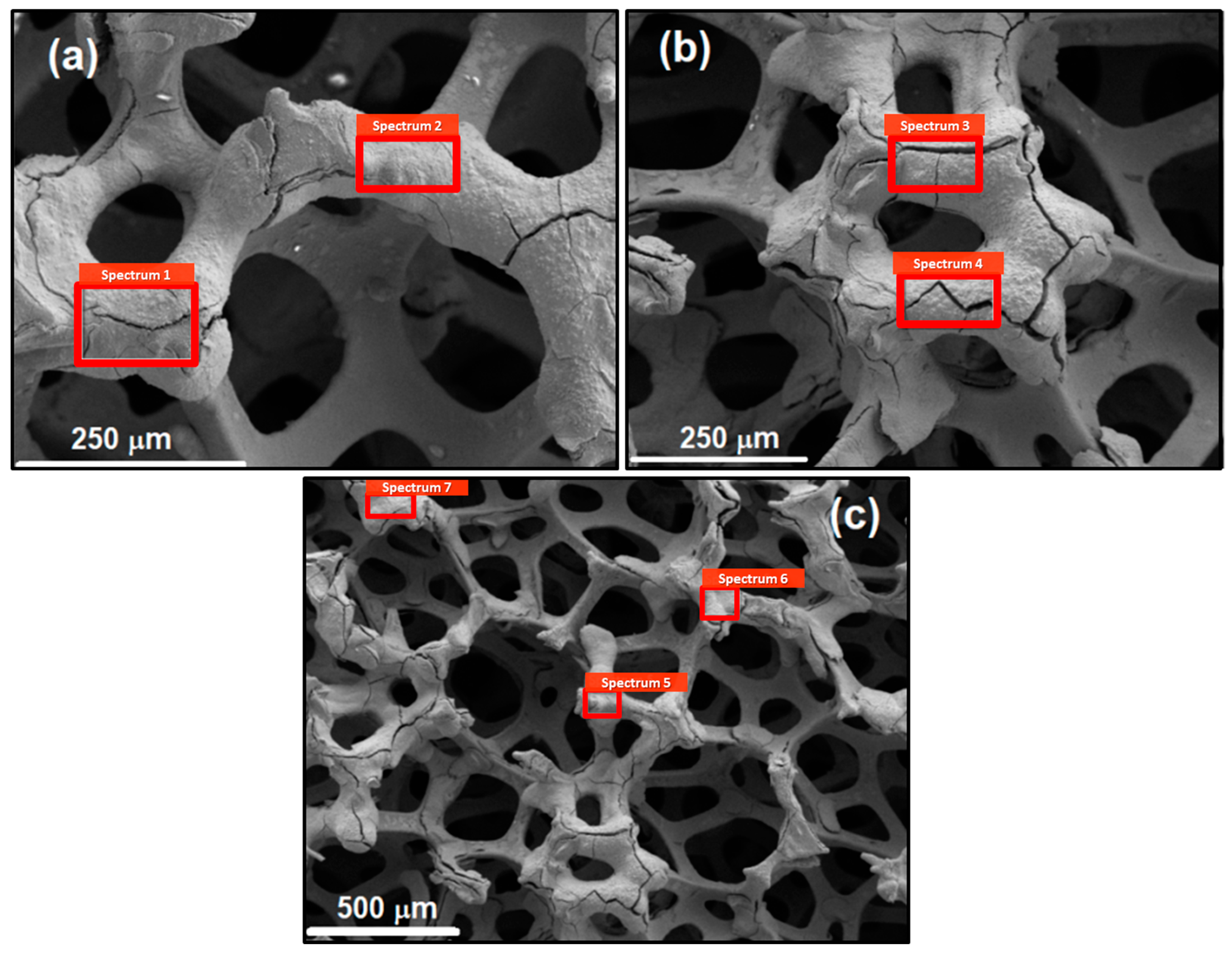


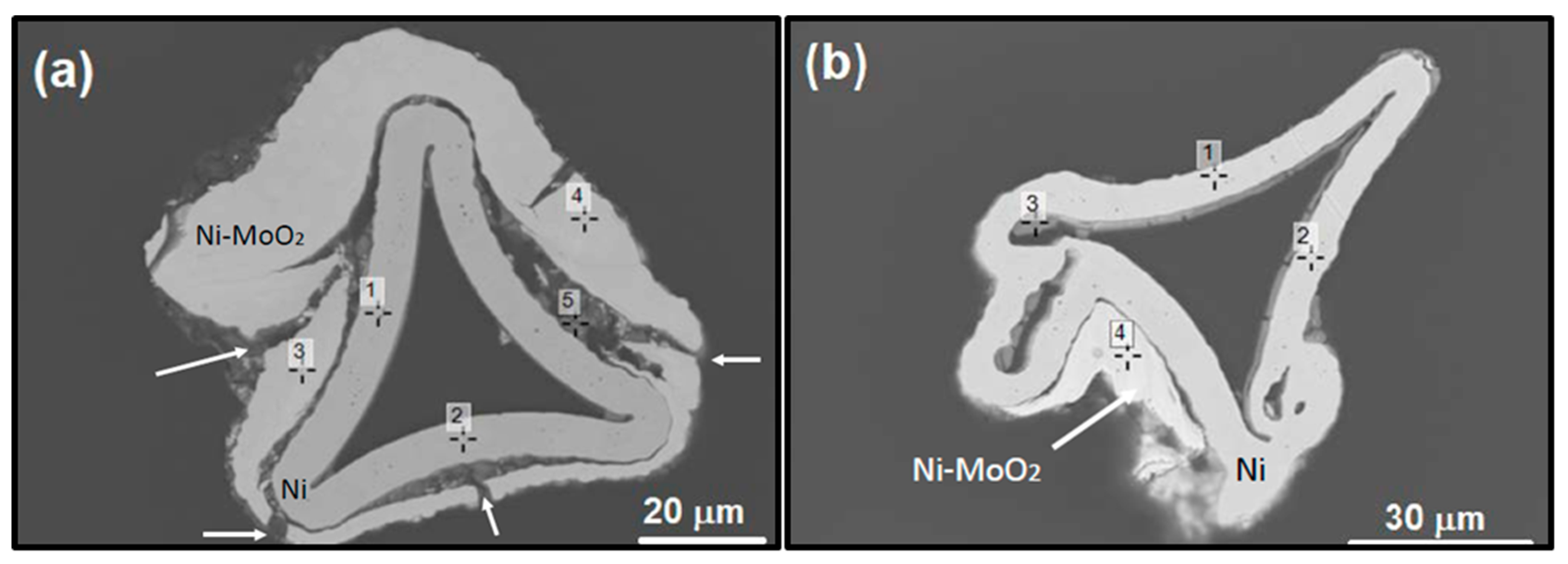

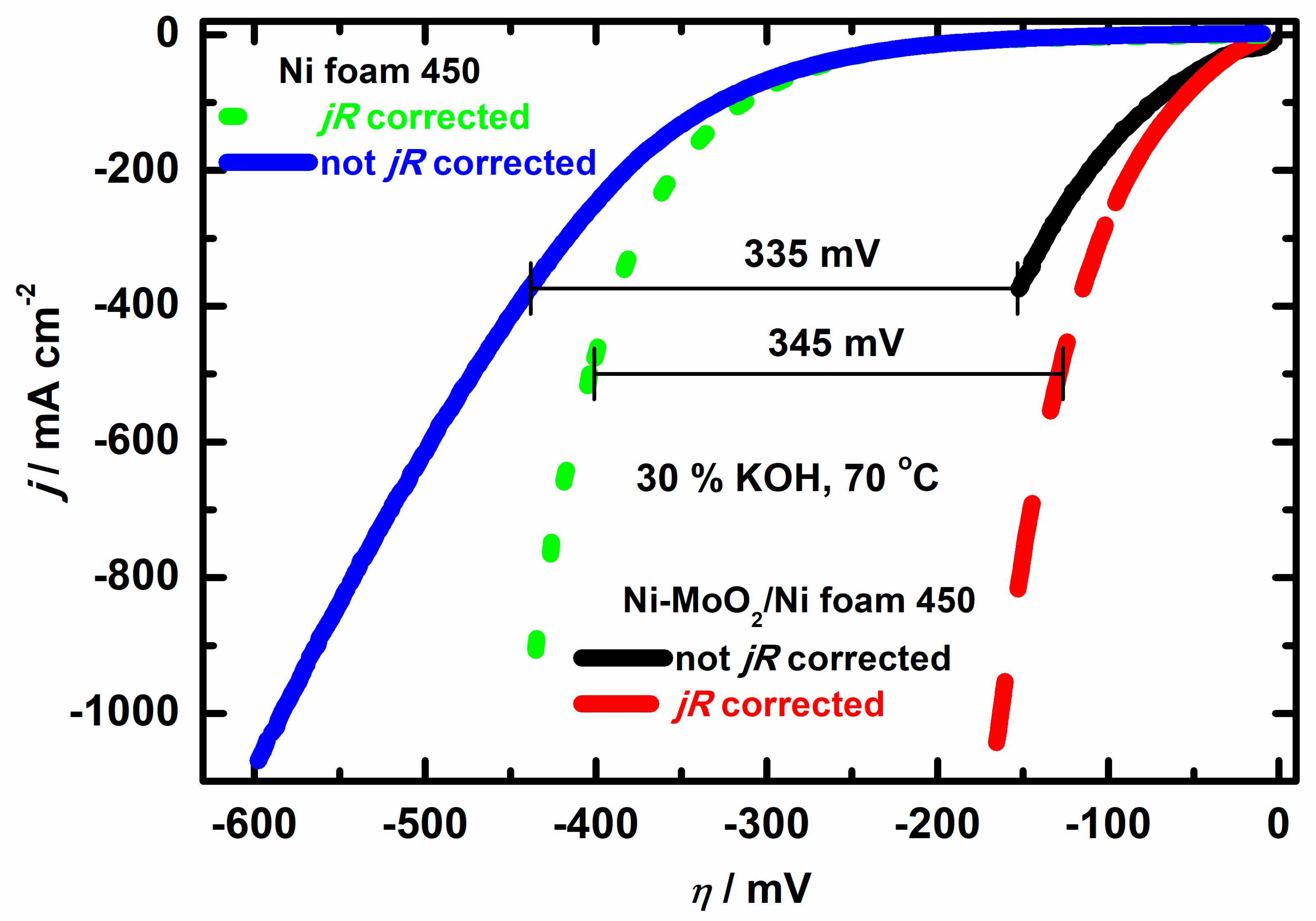
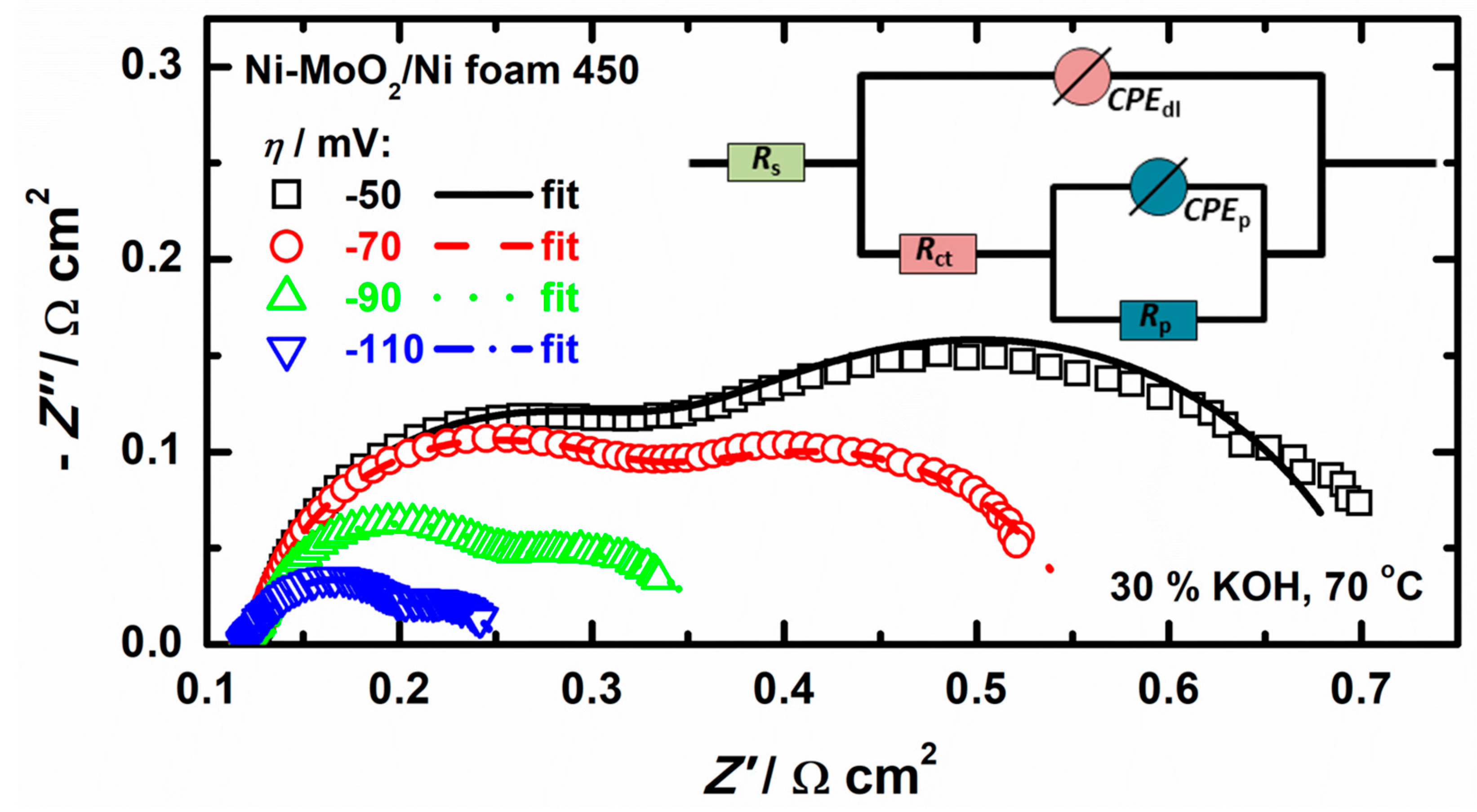
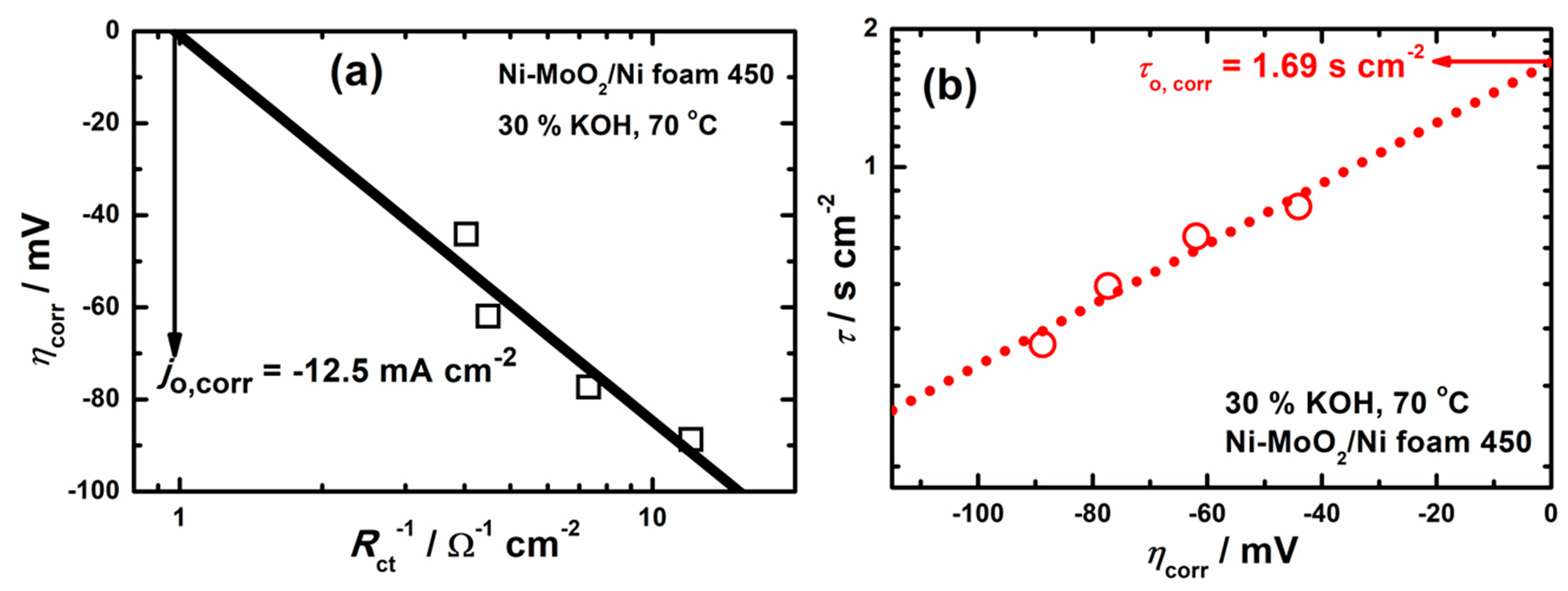


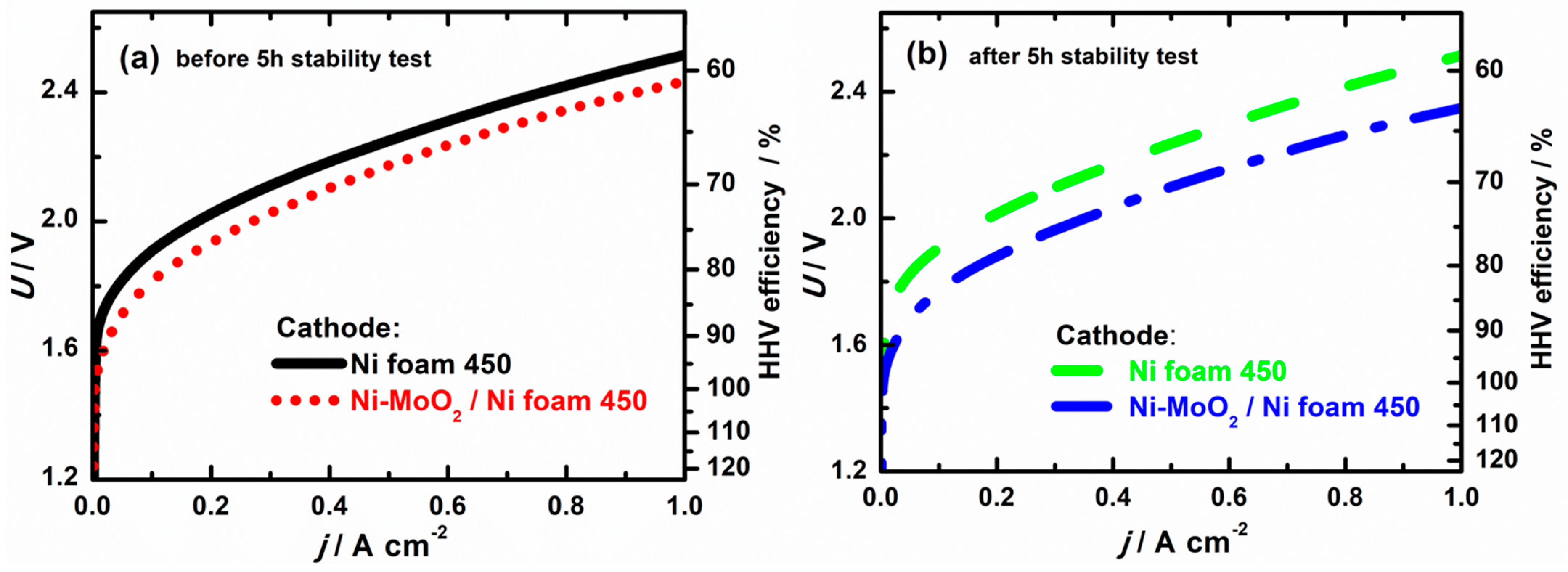
Disclaimer/Publisher’s Note: The statements, opinions and data contained in all publications are solely those of the individual author(s) and contributor(s) and not of MDPI and/or the editor(s). MDPI and/or the editor(s) disclaim responsibility for any injury to people or property resulting from any ideas, methods, instructions or products referred to in the content. |
© 2024 by the authors. Licensee MDPI, Basel, Switzerland. This article is an open access article distributed under the terms and conditions of the Creative Commons Attribution (CC BY) license (https://creativecommons.org/licenses/by/4.0/).
Share and Cite
Petričević, A.; Gojgić, J.; Bernäcker, C.I.; Rauscher, T.; Bele, M.; Smiljanić, M.; Hodnik, N.; Elezović, N.; Jović, V.D.; Krstajić Pajić, M.N. Ni-MoO2 Composite Coatings Electrodeposited at Porous Ni Substrate as Efficient Alkaline Water Splitting Cathodes. Coatings 2024, 14, 1026. https://doi.org/10.3390/coatings14081026
Petričević A, Gojgić J, Bernäcker CI, Rauscher T, Bele M, Smiljanić M, Hodnik N, Elezović N, Jović VD, Krstajić Pajić MN. Ni-MoO2 Composite Coatings Electrodeposited at Porous Ni Substrate as Efficient Alkaline Water Splitting Cathodes. Coatings. 2024; 14(8):1026. https://doi.org/10.3390/coatings14081026
Chicago/Turabian StylePetričević, Aleksandar, Jelena Gojgić, Christian I. Bernäcker, Thomas Rauscher, Marjan Bele, Milutin Smiljanić, Nejc Hodnik, Nevenka Elezović, Vladimir D. Jović, and Mila N. Krstajić Pajić. 2024. "Ni-MoO2 Composite Coatings Electrodeposited at Porous Ni Substrate as Efficient Alkaline Water Splitting Cathodes" Coatings 14, no. 8: 1026. https://doi.org/10.3390/coatings14081026





